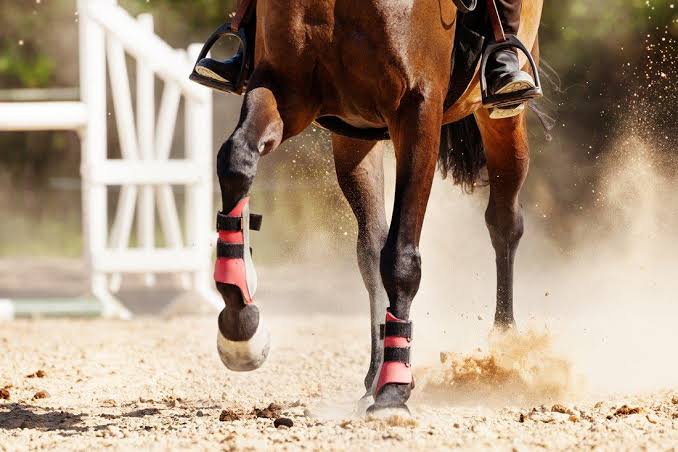Managing Your Performance Horse’s Joints

Understanding and Managing Equine Osteoarthritis: A Guide for Horse Owners
Osteoarthritis (OA) is a common and significant issue for horses, especially those involved in competitive activities. It's responsible for around 60% of lameness cases. OA is not just a concern for older horses; it frequently occurs in young, active horses due to the demands of their performance lifestyles.
What is Osteoarthritis?
OA is a "whole joint" disease, meaning it affects more than just the articular cartilage at the ends of bones. It also impacts the underlying bone, synovial membrane, joint capsule, supporting ligaments, and other structures like the menisci in the stifle joints. Inflammation from trauma, repeated stress, or injuries can lead to the production of catabolic proteins, which degrade cartilage and exacerbate OA.
One critical component in the progression of OA is a protein called IL-1 beta (IL-1β), which promotes inflammation and cartilage breakdown while hindering the body's ability to repair the damage.
Prevention Strategies
Weight Management: One of the most effective ways to prevent OA in horses is maintaining an optimal body weight. Excess weight can increase the stress on a horse's joints, leading to cartilage damage. Owners should be aware of the common issue of obesity in horses, which affects even those in competitive settings.
TRM Joint Supplements: Introducing joint supplements early can be a proactive measure to support joint health. TRM, a trusted name in equine nutrition, offers a range of joint supplements designed to maintain joint function and comfort.
TRM Stride: One standout product is TRM Stride, formulated with key ingredients such as glucosamine hydrochloride, chondroitin sulfate, and MSM (methylsulfonylmethane). These ingredients work synergistically to support the maintenance and repair of joint cartilage, reduce inflammation, and provide essential nutrients for overall joint health. Regular use of TRM Stride can help protect your horse's joints from the wear and tear of an active lifestyle, promoting longevity and peak performance.
Managing Osteoarthritis
Once OA has developed, it’s crucial to manage the condition to slow its progression and maintain the horse's comfort and mobility.
Medications: Non-steroidal anti-inflammatory drugs (NSAIDs) can help manage pain and inflammation, but they should be used cautiously, especially in performance horses. They are not typically the primary treatment option.
Intra-Articular Therapies: Veterinarians often use treatments directly injected into the joint to manage discomfort. These may include corticosteroids and hyaluronic acid, which help reduce inflammation and lubricate the joint. In recent years, the use of orthobiologics—therapies derived from natural substances—has gained popularity. These are believed to help protect cartilage and promote healing.
Conclusion
OA is an incurable condition, but with proper management and early intervention, the progression can be slowed, helping to maintain the horse's quality of life and performance. Owners should work closely with their veterinarians to implement a comprehensive care plan tailored to their horse's needs. Incorporating joint supplements like TRM Stride can be an integral part of a preventative and maintenance strategy for equine joint health.
Osteoarthritis (OA) is a common and significant issue for horses, especially those involved in competitive activities. It's responsible for around 60% of lameness cases. OA is not just a concern for older horses; it frequently occurs in young, active horses due to the demands of their performance lifestyles.
What is Osteoarthritis?
OA is a "whole joint" disease, meaning it affects more than just the articular cartilage at the ends of bones. It also impacts the underlying bone, synovial membrane, joint capsule, supporting ligaments, and other structures like the menisci in the stifle joints. Inflammation from trauma, repeated stress, or injuries can lead to the production of catabolic proteins, which degrade cartilage and exacerbate OA.
One critical component in the progression of OA is a protein called IL-1 beta (IL-1β), which promotes inflammation and cartilage breakdown while hindering the body's ability to repair the damage.
Prevention Strategies
Weight Management: One of the most effective ways to prevent OA in horses is maintaining an optimal body weight. Excess weight can increase the stress on a horse's joints, leading to cartilage damage. Owners should be aware of the common issue of obesity in horses, which affects even those in competitive settings.
TRM Joint Supplements: Introducing joint supplements early can be a proactive measure to support joint health. TRM, a trusted name in equine nutrition, offers a range of joint supplements designed to maintain joint function and comfort.
TRM Stride: One standout product is TRM Stride, formulated with key ingredients such as glucosamine hydrochloride, chondroitin sulfate, and MSM (methylsulfonylmethane). These ingredients work synergistically to support the maintenance and repair of joint cartilage, reduce inflammation, and provide essential nutrients for overall joint health. Regular use of TRM Stride can help protect your horse's joints from the wear and tear of an active lifestyle, promoting longevity and peak performance.
Managing Osteoarthritis
Once OA has developed, it’s crucial to manage the condition to slow its progression and maintain the horse's comfort and mobility.
Medications: Non-steroidal anti-inflammatory drugs (NSAIDs) can help manage pain and inflammation, but they should be used cautiously, especially in performance horses. They are not typically the primary treatment option.
Intra-Articular Therapies: Veterinarians often use treatments directly injected into the joint to manage discomfort. These may include corticosteroids and hyaluronic acid, which help reduce inflammation and lubricate the joint. In recent years, the use of orthobiologics—therapies derived from natural substances—has gained popularity. These are believed to help protect cartilage and promote healing.
Conclusion
OA is an incurable condition, but with proper management and early intervention, the progression can be slowed, helping to maintain the horse's quality of life and performance. Owners should work closely with their veterinarians to implement a comprehensive care plan tailored to their horse's needs. Incorporating joint supplements like TRM Stride can be an integral part of a preventative and maintenance strategy for equine joint health.


